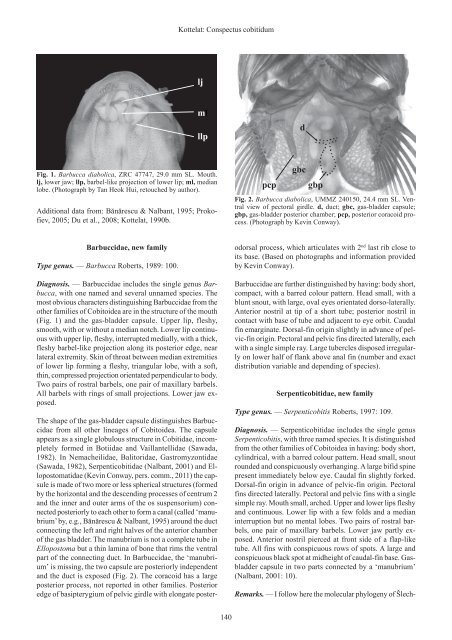Conspectus cobitidum - Raffles Museum of Biodiversity Research
Conspectus cobitidum - Raffles Museum of Biodiversity Research
Conspectus cobitidum - Raffles Museum of Biodiversity Research
You also want an ePaper? Increase the reach of your titles
YUMPU automatically turns print PDFs into web optimized ePapers that Google loves.
Fig. 1. Barbucca diabolica, ZRC 47747, 29.0 mm SL. Mouth.<br />
lj, lower jaw; llp, barbel-like projection <strong>of</strong> lower lip; ml, median<br />
lobe. (Photograph by Tan Heok Hui, retouched by author).<br />
Additional data from: Bănărescu & Nalbant, 1995; Prok<strong>of</strong>iev,<br />
2005; Du et al., 2008; Kottelat, 1990b.<br />
Barbuccidae, new family<br />
Type genus. — Barbucca Roberts, 1989: 100.<br />
Diagnosis. — Barbuccidae includes the single genus Barbucca,<br />
with one named and several unnamed species. The<br />
most obvious characters distinguishing Barbuccidae from the<br />
other families <strong>of</strong> Cobitoidea are in the structure <strong>of</strong> the mouth<br />
(Fig. 1) and the gas-bladder capsule. Upper lip, fleshy,<br />
smooth, with or without a median notch. Lower lip continuous<br />
with upper lip, fleshy, interrupted medially, with a thick,<br />
fleshy barbel-like projection along its posterior edge, near<br />
lateral extremity. Skin <strong>of</strong> throat between median extremities<br />
<strong>of</strong> lower lip forming a fleshy, triangular lobe, with a s<strong>of</strong>t,<br />
thin, compressed projection orientated perpendicular to body.<br />
Two pairs <strong>of</strong> rostral barbels, one pair <strong>of</strong> maxillary barbels.<br />
All barbels with rings <strong>of</strong> small projections. Lower jaw exposed.<br />
The shape <strong>of</strong> the gas-bladder capsule distinguishes Barbuccidae<br />
from all other lineages <strong>of</strong> Cobitoidea. The capsule<br />
appears as a single globulous structure in Cobitidae, incompletely<br />
formed in Botiidae and Vaillantellidae (Sawada,<br />
1982). In Nemacheilidae, Balitoridae, Gastromyzontidae<br />
(Sawada, 1982), Serpenticobitidae (Nalbant, 2001) and Ellopostomatidae<br />
(Kevin Conway, pers. comm., 2011) the capsule<br />
is made <strong>of</strong> two more or less spherical structures (formed<br />
by the horizontal and the descending processes <strong>of</strong> centrum 2<br />
and the inner and outer arms <strong>of</strong> the os suspensorium) connected<br />
posteriorly to each other to form a canal (called ‘manubrium’<br />
by, e.g., Bănărescu & Nalbant, 1995) around the duct<br />
connecting the left and right halves <strong>of</strong> the anterior chamber<br />
<strong>of</strong> the gas bladder. The manubrium is not a complete tube in<br />
Ellopostoma but a thin lamina <strong>of</strong> bone that rims the ventral<br />
part <strong>of</strong> the connecting duct. In Barbuccidae, the ‘manubrium’<br />
is missing, the two capsule are posteriorly independent<br />
and the duct is exposed (Fig. 2). The coracoid has a large<br />
posterior process, not reported in other families. Posterior<br />
edge <strong>of</strong> basipterygium <strong>of</strong> pelvic girdle with elongate poster-<br />
Kottelat: <strong>Conspectus</strong> <strong>cobitidum</strong><br />
lj<br />
ml<br />
llp<br />
140<br />
pcp<br />
d<br />
gbc<br />
gbp<br />
Fig. 2. Barbucca diabolica, UMMZ 240150, 24.4 mm SL. Ventral<br />
view <strong>of</strong> pectoral girdle. d, duct; gbc, gas-bladder capsule;<br />
gbp, gas-bladder posterior chamber; pcp, posterior coracoid process.<br />
(Photograph by Kevin Conway).<br />
odorsal process, which articulates with 2 nd last rib close to<br />
its base. (Based on photographs and information provided<br />
by Kevin Conway).<br />
Barbuccidae are further distinguished by having: body short,<br />
compact, with a barred colour pattern. Head small, with a<br />
blunt snout, with large, oval eyes orientated dorso-laterally.<br />
Anterior nostril at tip <strong>of</strong> a short tube; posterior nostril in<br />
contact with base <strong>of</strong> tube and adjacent to eye orbit. Caudal<br />
fin emarginate. Dorsal-fin origin slightly in advance <strong>of</strong> pelvic-fin<br />
origin. Pectoral and pelvic fins directed laterally, each<br />
with a single simple ray. Large tubercles disposed irregularly<br />
on lower half <strong>of</strong> flank above anal fin (number and exact<br />
distribution variable and depending <strong>of</strong> species).<br />
Serpenticobitidae, new family<br />
Type genus. — Serpenticobitis Roberts, 1997: 109.<br />
Diagnosis. — Serpenticobitidae includes the single genus<br />
Serpenticobitis, with three named species. It is distinguished<br />
from the other families <strong>of</strong> Cobitoidea in having: body short,<br />
cylindrical, with a barred colour pattern. Head small, snout<br />
rounded and conspicuously overhanging. A large bifid spine<br />
present immediately below eye. Caudal fin slightly forked.<br />
Dorsal-fin origin in advance <strong>of</strong> pelvic-fin origin. Pectoral<br />
fins directed laterally. Pectoral and pelvic fins with a single<br />
simple ray. Mouth small, arched. Upper and lower lips fleshy<br />
and continuous. Lower lip with a few folds and a median<br />
interruption but no mental lobes. Two pairs <strong>of</strong> rostral barbels,<br />
one pair <strong>of</strong> maxillary barbels. Lower jaw partly exposed.<br />
Anterior nostril pierced at front side <strong>of</strong> a flap-like<br />
tube. All fins with conspicuous rows <strong>of</strong> spots. A large and<br />
conspicuous black spot at midheight <strong>of</strong> caudal-fin base. Gasbladder<br />
capsule in two parts connected by a ‘manubrium’<br />
(Nalbant, 2001: 10).<br />
Remarks. — I follow here the molecular phylogeny <strong>of</strong> Šlech-

















